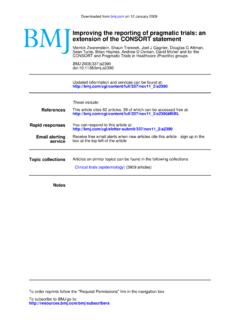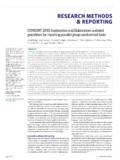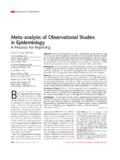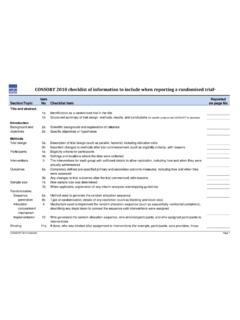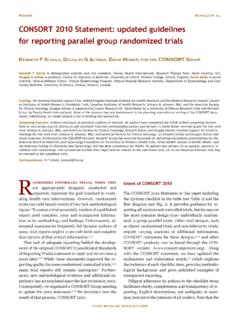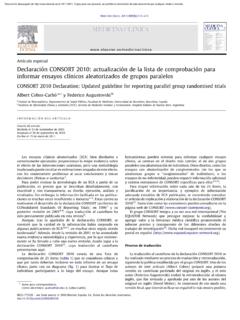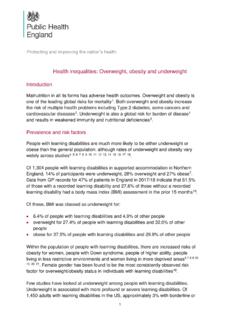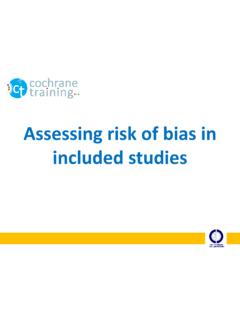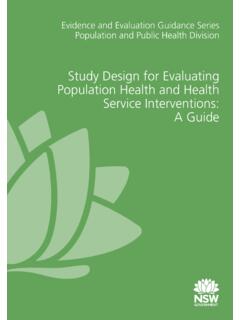Transcription of research methods & reporting - CONSORT Statement
1 698 BMJ | 27 March 2010 | VoluMe 340research methods & reportingThe CONSORT Statement is used worldwide to improve the reporting of randomised controlled trials. Kenneth schulz and colleagues describe the latest version, CONSORT 2010, which updates the reporting guideline based on new methodological evidence and accumulating experienceRandomised controlled trials, when appropriately designed, conducted, and reported, represent the gold standard in eval uating healthcare interventions. However, randomised trials can yield biased results if they lack methodological To assess a trial accurately, readers of a published report need complete, clear, and transparent information on its method ology and findings.
2 Unfortunately, attempted assessments frequently fail because authors of many trial reports neglect to provide lucid and complete descriptions of that critical 4 That lack of adequate reporting fuelled the development of the original CONSORT (Consolidated Standards of reporting Trials) Statement in 19965 and its revision five years 8 While those statements improved the reporting quality for some randomised controlled trials,9 10 many trial reports still remain Furthermore, new methodological evi 1 Family Health International, research Triangle Park, NC 27709, USA2 Centre for Statistics in Medicine, University of Oxford, Wolfson College, Oxford 3 Ottawa methods Centre, Clinical Epidemiology Program, Ottawa Hospital research Institute, Department of Epidemiology and Community Medicine, University of Ottawa, Ottawa, Canada correspondence to.
3 K F Schulz 9 December 2009 Cite this as: BMJ 2010;340:c332doi: 2010 Statement : updated guidelines for reporting parallel group randomised trialsKenneth F Schulz,1 Douglas G Altman,2 David Moher,3 for the CONSORT GroupFlow diagram of the progress through the phases of a parallel randomised trial of t wo groups (that is, enrolment, intervention allocation, follow-up, and data analysis)Allocated to intervention (n=..): Received allocated intervention (n=..) Did not receive allocated intervention (give reasons) (n=..)Allocated to intervention (n=..): Received allocated intervention (n=.)
4 Did not receive allocated intervention (give reasons) (n=..)AllocationEnrolmentFollow-upAnalys isAssessed for eligibility (n=..) randomised (n=..)Lost to follow-up (give reasons) (n=..)Discontinued intervention (give reasons) (n=..)Lost to follow-up (give reasons) (n=..)Discontinued intervention (give reasons) (n=..)Analysed (n=..): Excluded from analysis (give reasons) (n=..)Analysed (n=..): Excluded from analysis (give reasons) (n=..)Excluded (n=..): Not meeting inclusion criteria (n=..) Declined to participate (n=..) Other reasons (n=..)dence and additional experience has accumulated since the last revision in 2001.
5 Consequently, we organised a C ONSORT Group meeting to update the 2001 8 We introduce here the result of that process, CONSORT of CONSORT 2010 The CONSORT 2010 Statement is this paper including the 25 item checklist in the table and the flow diagram. It pro vides guidance for reporting all randomised controlled trials, but focuses on the most common design type individually randomised , two group, parallel trials. Other trial designs, such as cluster randomised trials and non inferiority tri als, require varying amounts of additional information. CO NSORT extensions for these designs,11 12 and other CONSORT products, can be found through the CONSORT website ( ).
6 Along with the CONSORT Statement , we have updated the explanation and elaboration article,13 which explains the inclusion of each checklist item, provides methodological background, and gives published examples of transparent adherence by authors to the checklist items facili tates clarity, completeness, and transparency of reporting . Explicit descriptions, not ambiguity or omission, best serve the interests of all readers. Note that the CONSORT 2010 Statement does not include recommendations for design ing, conducting, and analysing trials. It solely addresses the reporting of what was done and what was , CONSORT does indirectly affect design and conduct.
7 Transparent reporting reveals deficiencies in research if they exist. Thus, investigators who conduct inad equate trials, but who must transparently report, should not be able to pass through the publication process without revelation of their trial s inadequacies. That emerging reality should provide impetus to improved trial design and conduct in the future, a secondary indirect goal of our work. Moreover, CONSORT can help researchers in designing their to consortEfforts to improve the reporting of randomised control led t rials accelerated in the mid 1990s, spurred partly by methodological research .
8 Researchers had shown for many years that authors reported such trials poorly, and empiri cal evidence began to accumulate that some poorly con ducted or poorly reported aspects of trials were associated with Two initiatives aimed at developing reporting guidelines culminated in one of us (DM) and Drummond Rennie organising the first CONSORT Statement in editorial by antesresearch, p 697 BMJ | 27 March 2010 | VoluMe 340 699research methods & reportingconsort 2010 checklist of information to include when reporting a randomised trial*Section/TopicItem NoChecklist itemTitle and abstract1aIdentification as a randomised trial in the title1bStructured summary of trial design, methods , results, and conclusions (for specific guidance see CONSORT for abstracts21 31)
9 IntroductionBackground and objectives2aScientific background and explanation of rationale2bSpecific objectives or hypothesesMethodsTrial design3aDescription of trial design (such as parallel, factorial) including allocation ratio3bImportant changes to methods after trial commencement (such as eligibility criteria), with reasonsParticipants4aEligibility criteria for participants4bSettings and locations where the data were collectedInterventions5 The interventions for each group with sufficient details to allow replication, including how and when they were actually administeredOutcomes6aCompletely defined pre-specified primary and secondary outcome measures, including how and when they were assessed6bAny changes to trial outcomes after the trial commenced, with reasonsSample size7aHow sample size was determined7bWhen applicable.
10 Explanation of any interim analyses and stopping guidelinesRandomisation: Sequence generation8aMethod used to generate the random allocation sequence8bType of randomisation; details of any restriction (such as blocking and block size) Allocation concealment mechanism9 Mechanism used to implement the random allocation sequence (such as sequentially numbered containers), describing any steps taken to conceal the sequence until interventions were assignedImplementation10 Who generated the random allocation sequence, who enrolled participants, and who assigned participants to interventionsBlinding11aIf done, who was blinded after assignment to interventions (for example, participants, care providers, those assessing outcomes)
